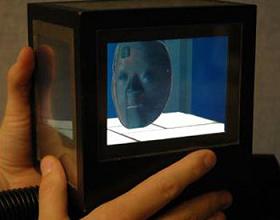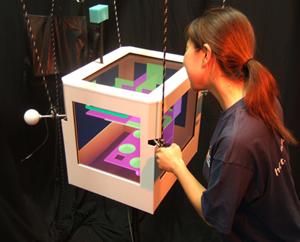
Most virtual reality developers want to transport you inside an artificial world, the University of British Columbia hopes to place that world in your hands. pCubee is a small cube with five LCD screens on its sides. Stare at pCubee and it feels like you’re looking a 3D environment inside the box – a Fish Tank Virtual Reality (FTVR). Users wear a head tracking device, allowing pCubee to correctly present you with depth perception and motion parallax on each of its sides – it’s a personalized experience (hence the ‘p’ in pCubee). Sensors inside the box also allow you to affect the virtual world by shaking or tilting the cube. Besides giving you god-like powers over the residents of the virtual environment, pCubee will hopefully provide new ways of enhancing entertainment, education, designing, and teleconferencing. Check out the video below to see the pCubee put through its paces, this may be your first chance to watch a FTVR in action.
When it comes to displaying 3D real and virtual objects, it seems like everyone has their own approach. We’ve seen rapidly spinning mirrors reflecting carefully calibrated projectors, stereoscopic TV diplays meant to be watched with shuttering glasses, ultra rigid thin films set at angles, and even just multiple projections on a 3D enclosure. All of these systems look cool, but most are probably too impractical to become popular. pCubee is a fairly simple setup (5 LCD screens on a box) which may make it the easiest to adopt as a new human computer interface. I won’t tempt the Fates by trying to predict which system will eventually prevail, but it seems clear that with all these teams competing to present a workable 3D system at least one will be successful.
The pCubee looks really amazing, but I think the video only highlights some of the potential of FTVR. An enclosed virtual environment (of whatever size) gives you the ability to combine visual and kinetic learning in one place. You could use the pCubee to give you insights into 3D objects in ways that flat panels alone simply can’t convey. Need to understand a microscopic object? Port a virtual copy of it into the pCubee and you can roll it around, interact with it, and examine it from every angle. Add in haptics and some touchscreens, and you come close to creating the ability to hold and feel a virtual object just like a real one.

It’s not quite clear where the pCubee could find its best application. The entertainment and education opportunities are numerous, but UBC has a larger version (the Cubee) which may work better in a shared setting. Drafting or some other form of 3D design seems like a good choice. According to the paper they’ll present at the upcoming CHI 2010, the UBC team had good success when they paired the pCubee with a standard mouse. This sort of bimanual manipulation (one hand moving the cube, one hand using the mouse) gives you some precise control over the entire VR world as a whole as well as precise prodding of the items inside of it. The team even built a prototype stylus (seen at 1:50) which could be take the place of the mouse for some applications.
When I wade through all the augmented reality, virtual reality, and teleconferencing options I start to wonder if each of these systems won’t specialize into niche markets. You’re probably never going to want a pCubee to present a 3D copy of yourself for a virtual conference (tell the CEO to stop shaking the intern!), but for engineering or design work it seems like a great fit. Accordingly, in the short term we may not find one successful 3D system but a plurality of them each relegated to its own particular use. Eventually brain computer interfaces or fully immersive haptic VR systems are likely to replace all other such 3D attempts. Those advanced technologies could take many years to come around, so in the meantime it will be interesting to see how LCD screens, mirrors, and projectors push the public into 3D displays. I’m not sure how popular the pCubee will be, but I kind of want one. Holding a FTVR in my hands would be pretty awesome. Reminds me of Horton Hears a Who.
[image credit: University of British Columbia]
[source: University of British Columbia, Cubee site, Stavness et al, CHI 2010]


